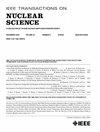A Novel Method for Simulating Transient Signals in Diamond Thermal Neutron Detectors
IF 1.9
3区 工程技术
Q3 ENGINEERING, ELECTRICAL & ELECTRONIC
引用次数: 0
Abstract
Neutrons have extensive applications across a wide range of fields. Diamond, with its excellent physical properties, holds great promise for neutron detection. However, the probability of thermal neutron interaction with diamond is relatively low, leading to the common use of 6LiF as a conversion layer. Beyond the inherent properties of the conversion layer, the detection efficiency of a detector is influenced not only by the spatial collection of secondary particles but also by the electrical characteristics of the device. Theoretical simulations can extract important parameters of the device and reveal significant physical processes. This article establishes a simulation framework using technology computer-aided design (TCAD), stopping and range of ions in matter (SRIM), and Garfield++. The simulation process involves using Sentaurus TCAD software to model the electrical characteristics of diamond detectors, employing SRIM to accurately simulate the deposition energy interaction of charged secondary particles with diamonds, and leveraging Garfield++ to generate detector signals accurately using electrical characteristics and nuclear reaction data. By simulating the signals of both planar and trench-type microstructure detectors, the research explores the impacts of various factors, including the applied voltage, the energy of secondary particles, and the angle of incidence on the dynamic response process. The proposed coupled simulation method plays a key role in the fabrication and experimental design of thermal neutron detectors, providing crucial insights and guidance to optimize detector performance and design readout circuits.金刚石热中子探测器瞬态信号模拟的新方法
中子在许多领域都有广泛的应用。金刚石具有优良的物理性质,在中子探测方面具有很大的前景。然而,热中子与金刚石相互作用的概率相对较低,因此通常使用6LiF作为转换层。除了转换层的固有特性外,探测器的探测效率不仅受到二次粒子空间收集的影响,还受到器件电特性的影响。理论模拟可以提取器件的重要参数,揭示重要的物理过程。本文利用计算机辅助设计(TCAD)技术、物质中离子停止与范围(SRIM)技术和Garfield++技术建立了一个仿真框架。仿真过程包括利用Sentaurus TCAD软件对金刚石探测器的电学特性进行建模,利用SRIM精确模拟带电二次粒子与金刚石的沉积能量相互作用,利用Garfield++利用电学特性和核反应数据准确生成探测器信号。通过模拟平面型和沟槽型微结构探测器的信号,探讨了外加电压、二次粒子能量、入射角等因素对动态响应过程的影响。所提出的耦合模拟方法在热中子探测器的制造和实验设计中起着关键作用,为优化探测器性能和设计读出电路提供了重要的见解和指导。
本文章由计算机程序翻译,如有差异,请以英文原文为准。
求助全文
约1分钟内获得全文
求助全文
来源期刊

IEEE Transactions on Nuclear Science
工程技术-工程:电子与电气
CiteScore
3.70
自引率
27.80%
发文量
314
审稿时长
6.2 months
期刊介绍:
The IEEE Transactions on Nuclear Science is a publication of the IEEE Nuclear and Plasma Sciences Society. It is viewed as the primary source of technical information in many of the areas it covers. As judged by JCR impact factor, TNS consistently ranks in the top five journals in the category of Nuclear Science & Technology. It has one of the higher immediacy indices, indicating that the information it publishes is viewed as timely, and has a relatively long citation half-life, indicating that the published information also is viewed as valuable for a number of years.
The IEEE Transactions on Nuclear Science is published bimonthly. Its scope includes all aspects of the theory and application of nuclear science and engineering. It focuses on instrumentation for the detection and measurement of ionizing radiation; particle accelerators and their controls; nuclear medicine and its application; effects of radiation on materials, components, and systems; reactor instrumentation and controls; and measurement of radiation in space.
 求助内容:
求助内容: 应助结果提醒方式:
应助结果提醒方式:


